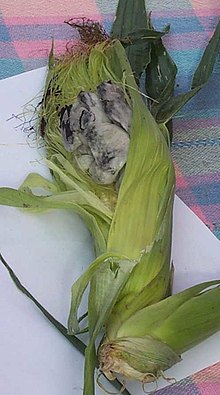| Ustilaginaceae | |
|---|---|

| |
| Ustilago maydis | |
| Scientific classification | |
| Domain: | Eukaryota |
| Kingdom: | Fungi |
| Division: | Basidiomycota |
| Class: | Ustilaginomycetes |
| Order: | Ustilaginales |
| Family: | Ustilaginaceae Tul. & C.Tul. (1847) |
| Type genus | |
| Ustilago (Pers.) Roussel (1806) | |
The Ustilaginaceae are a family of smut fungi in the order Ustilaginomycetes. Collectively, the family contains 17 genera and 607 species.
Biotechnological relevance
Ustilaginaceae naturally produce a wide range of value-added chemicals (e.g. secondary metabolites, TCA cycle intermediates) with growing biotechnological interest. Reported metabolites are polyols, organic acids, extracellular glycolipids, iron-chelating siderophores and tryptophan derivatives. Polyols, such as erythritol (ery) and mannitol, for example, have large markets as sweeteners for diabetics and as facilitating agents for the transportation of pharmaceuticals in medicine. Itaconic, L-malic, succinic, l-itatartaric, and l-2-hydroxyparaconic acid are organic acids produced by many Ustilaginomycetes. Applications for itaconic acid are for example the production of resins, plastics, adhesives, elastomers, coatings, and nowadays itaconate is discussed as a platform chemical in the production of biofuels. Malic acid is used in many food products, primarily as an acidulant. Succinic acid is utilized as a precursor to pharmaceutical ingredients, such as additives, solvents, and polymers, but also as a food additive and dietary supplement. Another category of metabolites produced by smut fungi contains extracellular glycolipids, such as mannosylerythritol lipids and ustilagic acid. These lipids have biosurfactant properties and can be used in pharmaceutical, cosmetic, and food applications and are known for their strong fungicidal activity on many species.
Genera
With authors and amount of species per genus;
- Ahmadiago Vánky (1)
- Aizoago Vánky (2)
- Anomalomyces Vánky, M. Lutz & R.G. Shivas (2)
- Anthracocystis Bref. (134)
- Bambusiomyces Vánky (1)
- Centrolepidosporium R.G. Shivas & Vánky (1)
- Dirkmeia F.Y. Bai, Q.M. Wang, Begerow & Boekhout (1)
- Eriocaulago Vánky (2)
- Eriomoeszia Vánky (1)
- Eriosporium (E. Müll.) Vánky (2)
- Franzpetrakia Thirum. & Pavgi (3)
- Kalmanozyma Q.M. Wang, F.Y. Bai, Begerow & Boekhout (3)
- Langdonia McTaggart & R.G. Shivas (8)
- Macalpinomyces Langdon & Full. (41)
- Melanopsichium Beck (2)
- Moesziomyces Vánky (7)
- Parvulago R. Bauer, M. Lutz, Piątek, Vánky & Oberw. (1)
- Pattersoniomyces Piątek, M. Lutz & C.A. Rosa (1)
- Shivasia Vánky, M. Lutz & Piątek (1)
- Sporisorium Ehrenb. ex Link (195)
- Stollia McTaggart & R.G. Shivas (5)
- Tranzscheliella Lavrov (17)
- Triodiomyces McTaggart & R.G. Shivas (6)
- Ustilago (Pers.) Roussel (170)
- Yunchangia L. Guo & B. Xu (1)
References
- Kirk MP, Cannon PF, Minter DW, Stalpers JA (2008). Dictionary of the Fungi (10th ed.). Wallingford, UK: CAB International. p. 716. ISBN 978-0-85199-826-8.
- Geiser, Elena; Wiebach, Vincent; Wierckx, Nick; Blank, Lars M. (2014-01-01). "Prospecting the biodiversity of the fungal family Ustilaginaceae for the production of value-added chemicals". Fungal Biology and Biotechnology. 1: 2. doi:10.1186/s40694-014-0002-y. ISSN 2054-3085. PMC 5598272. PMID 28955444.
- ^ Feldbrügge, Michael; Kellner, Ronny; Schipper, Kerstin (2013-03-02). "The biotechnological use and potential of plant pathogenic smut fungi". Applied Microbiology and Biotechnology. 97 (8): 3253–3265. doi:10.1007/s00253-013-4777-1. ISSN 0175-7598. PMID 23455565. S2CID 18520974.
- ^ Guevarra, Elvira D.; Tabuchi, Takeshi (1990-01-01). "Accumulation of Itaconic, 2-Hydroxyparaconic, Itatartaric, and Malic Acids by Strains of the Genus Ustilago". Agricultural and Biological Chemistry. 54 (9): 2353–2358. doi:10.1271/bbb1961.54.2353.
- Moon, Hee-Jung; Jeya, Marimuthu; Kim, In-Won; Lee, Jung-Kul (2010-02-26). "Biotechnological production of erythritol and its applications". Applied Microbiology and Biotechnology. 86 (4): 1017–1025. doi:10.1007/s00253-010-2496-4. ISSN 0175-7598. PMID 20186409. S2CID 9560435.
- Willke, Th; Vorlop, K.-D. (2001). "Biotechnological production of itaconic acid". Applied Microbiology and Biotechnology. 56 (3–4): 289–295. doi:10.1007/s002530100685. ISSN 0175-7598. PMID 11548996. S2CID 206934753.
- Tsao, G. T.; Cao, N. J.; Du, J.; Gong, C. S. (1999-01-01). Tsao, Prof Dr G. T.; Brainard, A. P.; Bungay, H. R.; Cao, N. J.; Cen, P.; Chen, Z.; Du, J.; Foody, B.; Gong, C. S. (eds.). Production of Multifunctional Organic Acids from Renewable Resources. Advances in Biochemical Engineering/Biotechnology. Vol. 65. Springer Berlin Heidelberg. pp. 243–280. doi:10.1007/3-540-49194-5_10. ISBN 9783540655770. PMID 10533437.
- Zeikus, J. G.; Jain, M. K.; Elankovan, P. (1999). "Biotechnology of succinic acid production and markets for derived industrial products". Applied Microbiology and Biotechnology. 51 (5): 545–552. doi:10.1007/s002530051431. ISSN 0175-7598. S2CID 38868987.
- Morita, Tomotake; Fukuoka, Tokuma; Imura, Tomohiro; Kitamoto, Dai (2009-05-01). "Production of glycolipid biosurfactants by basidiomycetous yeasts". Biotechnology and Applied Biochemistry. 53 (1): 39–49. doi:10.1042/BA20090033. ISSN 1470-8744. PMID 19341364. S2CID 27322169.
- Bölker, Michael; Basse, Christoph W.; Schirawski, Jan (2008-08-01). "Ustilago maydis secondary metabolism—From genomics to biochemistry". Fungal Genetics and Biology. Thematic Issue: Ustilago maydis. 45, Supplement 1: S88 – S93. doi:10.1016/j.fgb.2008.05.007. PMID 18585066.
- Wijayawardene, Nalin; Hyde, Kevin; Al-Ani, Laith Khalil Tawfeeq; Somayeh, Dolatabadi; Stadler, Marc; Haelewaters, Danny; et al. (2020). "Outline of Fungi and fungus-like taxa". Mycosphere. 11: 1060–1456. doi:10.5943/mycosphere/11/1/8. hdl:10481/61998.
- Vánky K. (2011). "Bambusiomyces, a new genus of smut fungi" (PDF). Mycologia Balcanica. 8: 141–5. Archived from the original (PDF) on 2013-11-12.
External links
This Ustilaginomycotina-related article is a stub. You can help Misplaced Pages by expanding it. |